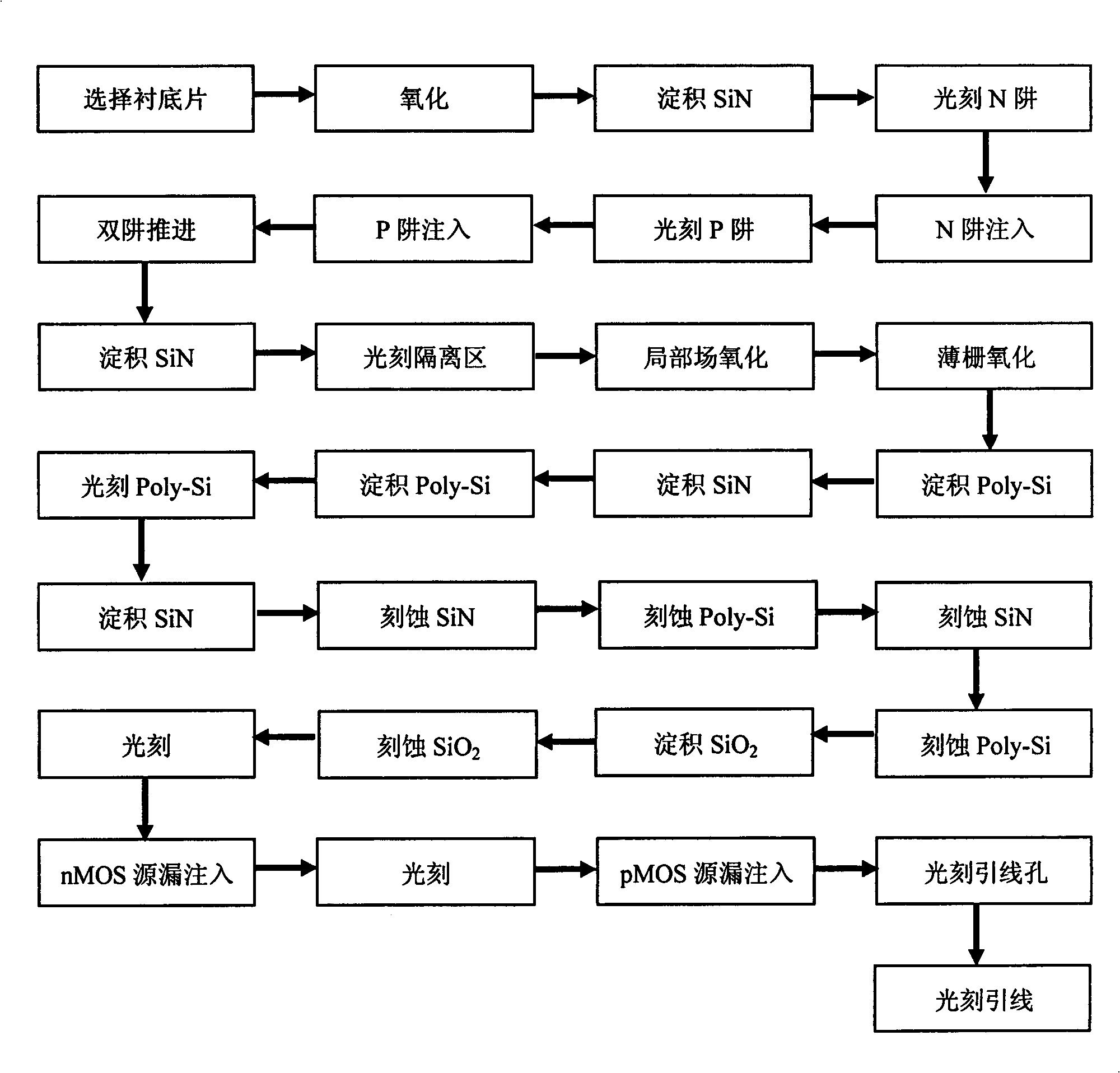Method for preparing nano CMOS integrated circuit by SiN masking technique
An integrated circuit and nanoscale technology, applied in the manufacture of circuits, electrical components, semiconductors/solid-state devices, etc., can solve the problems of waste of resources and energy, restrictions on the development of the semiconductor industry, and rising production costs, and achieve small conductive channels and realize The effect of leapfrog development and improvement of manufacturing capacity
- Summary
- Abstract
- Description
- Claims
- Application Information
AI Technical Summary
Problems solved by technology
Method used
Image
Examples
Embodiment 1
[0030] Embodiment 1: Prepare a CMOS integrated circuit with a 45nm conduction channel on a Si substrate. The specific steps are as follows:
[0031] Step 1, deposit a masking layer, as shown in Figure 2(a).
[0032] (1a) Select the crystal orientation as and the doping concentration as 10 15 cm -3 Left and right p-type Si substrate sheet 1;
[0033] (1b) Thermally oxidize a layer of 40nm thick SiO on the substrate 2 Buffer layer 2;
[0034] (1c) In SiO 2 A 100nm thick SiN layer 3 is deposited on the buffer layer by a low pressure chemical vapor deposition LPCVD method, which is used for masking the implantation of the well region.
[0035] Step 2, forming a well region, as shown in Figure 2(b).
[0036] (2a) The P-well region 4 and the N-well region 5 are respectively lithographically etched on the SiN layer 3 in the order of phases;
[0037] (2b) Boron is implanted in the P-well region to form a p-type region, and the surface of the P-well region is thermally oxidized to form Si...
Embodiment 2
[0065] Embodiment 2: Prepare a CMOS integrated circuit with a 65nm conductive channel on an SOI substrate, the specific steps are as follows:
[0066] Step 1, deposit a masking layer, as shown in Figure 2(a).
[0067] (1a) Select the crystal orientation as and the doping concentration as 10 15 cm -3 Left and right p-type SOI substrate sheet 1;
[0068] (1b) Thermal oxidation of a layer of 40nm thick SiO on the substrate 2 Buffer layer 2;
[0069] (1c) In SiO 2 A 100nm thick SiN layer 3 is deposited on the buffer layer by APCVD method, which is used for the masking of the well region implantation.
[0070] Step 2, forming a well region, as shown in Figure 2(b).
[0071] (2a) Photoetching the P-well region 4 and the N-well region 5 on the SiN layer 3 in the order of phases;
[0072] (2b) Boron is implanted in the P-well region to form a p-type region, and the surface of the P-well region is thermally oxidized to form SiO 2 , P-well advancement is performed at the same time, and P-w...
Embodiment 3
[0100] Embodiment 3: Prepare a CMOS integrated circuit with a conduction channel of 90 nm on a Si substrate. The specific steps are as follows:
[0101] Step 1, deposit a masking layer, as shown in Figure 2(a).
[0102] (1a) Select the crystal orientation as and the doping concentration as 10 15 cm -3 Left and right p-type Si substrate sheet 1;
[0103](1b) Thermal oxidation of a layer of 40nm thick SiO on the substrate 2 Buffer layer 2;
[0104] (1c) In SiO 2 A 100nm thick SiN layer 3 is deposited on the buffer layer by means of plasma enhanced chemical vapor deposition (PECVD), which is used for masking the implantation of the well region.
[0105] Step 2, forming a well region, as shown in Figure 2(b).
[0106] (2a) Photoetching the P-well region 4 and the N-well region 5 on the SiN layer 3 in the order of phases;
[0107] (2b) Boron is implanted in the P-well region to form a p-type region, and the surface of the P-well region is thermally oxidized to form SiO 2 , P-well adva...
PUM
 Login to View More
Login to View More Abstract
Description
Claims
Application Information
 Login to View More
Login to View More - R&D
- Intellectual Property
- Life Sciences
- Materials
- Tech Scout
- Unparalleled Data Quality
- Higher Quality Content
- 60% Fewer Hallucinations
Browse by: Latest US Patents, China's latest patents, Technical Efficacy Thesaurus, Application Domain, Technology Topic, Popular Technical Reports.
© 2025 PatSnap. All rights reserved.Legal|Privacy policy|Modern Slavery Act Transparency Statement|Sitemap|About US| Contact US: help@patsnap.com



